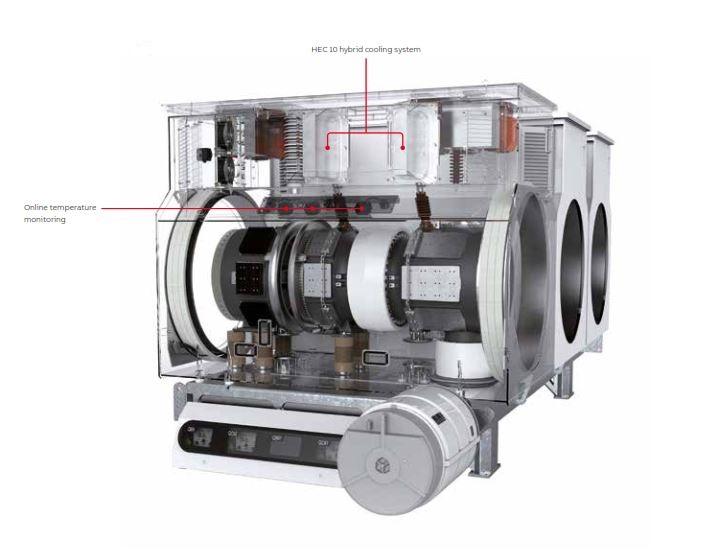
Photo from HITACHI-ABB power grid company GCB type HEC 10( ABB review Energy pdf file)
Introduction to generator circuit breaker standard:
In April 2013, the joint IEC/IEEE generator circuit breaker working group met to revise the IEEE C37.013 standards to satisfy the needs of both IEC and IEEE users. Assigning a “Dual Logo” standard presented a challenge. Due to existing rules, IEC would not allow letters and periods in identifying the standard. For this reason, it was decided and approved by both IEC and IEEE that the new edition will be designated 62271-37-013. The content of the standard increased from 113 pages to 200 pages.
One of the major differences between IEC/IEEE 62271-37-013 and the old IEEE C37.013 is the requirement on the degree of asymmetry of the generator-source short-circuit currents, which are characterized by having delayed natural zero-crossings for a certain period. This requirement was raised from 110 percent to 130 percent to better represent the requirements of real applications.
In particular, the new dual logo standard defines two classes, G1 and G2; the latter being Of higher performance.
Generator circuit breaker (GCB) is classified in terms of breaking capacity according to IEC/IEEE 62271-37-013 to class G1 & class G2.
The rated generator-source short-circuit breaking current is the highest generator-source short-circuit current at contact separation, which the generator circuit-breaker shall be capable of breaking under the conditions of use and behavior prescribed in IEC/IEEE 62271-37-013 standard.
Such a current is found in a circuit having a power-frequency recovery voltage corresponding to the rated voltage of the generator circuit breaker and having a transient recovery voltage equal to the value specified in IEC/IEEE 62271-37-013. For three-pole generator circuit-breakers, the a.c.
component relates to a three-phase earthed short circuit. The source of the short-circuit current is entirely from a generator through no transformations.
The rated generator-source short-circuit breaking current is characterized by two values:
a) the r.m.s. value of its a.c. the component at contact separation Iscg
b) the degree of asymmetry at contact separation Asycs
Generator circuit-breaker class G1 definition:
Generator circuit-breaker having a rated generator-source short-circuit breaking current characterized at contact separation by a degree of asymmetry of 110 % with the assigned a.c. component of the rated generator-source short-circuits breaking current and a degree of asymmetry of 130 % with a current having an a.c. component equal to 74 % of the assigned a.c. component of the rated generator-source short-circuits breaking current.
It means:
A class G1 GCB having a rated generator-source short-circuit breaking current equal to Iscg (the root-mean-square value of the symmetrical component of the prospective short-circuit current for faults fed by the generator) shall be proved by two tests: one with a current equal to Iscg with a degree of asymmetry of 110 percent and one with a current equal to 0.74 x Iscg and a degree of asymmetry of 130 percent.
Generator circuit-breaker class G2 definition:
Generator circuit-breaker having a rated generator-source short-circuit breaking current characterized at contact separation by a degree of asymmetry of 130 % with the assigned a.c. component of the rated generator-source short-circuits breaking current.
It means:
A class G2 GCB having a rated generator-source short-circuit breaking current equal to Iscg shall be proved by one test with a current equal to Iscg with a 130 percent degree of asymmetry.
Asymmetrical current breaking test duties for generator circuit breaker:
The asymmetrical current breaking tests shall be performed according to test duties 5 and 6A for class G1 generator circuit-breakers or according to test duty 6B for G2 class generator circuit breakers.
For test-duty 5 the test procedure shall include a prospective test current waveform where the r.m.s. value of the a.c. component of this current is Iscg and current peaks and relative minimums until the first current zero-crossing shall be recorded. The prospective test current waveform shall have a minimum of three full cycles before the first current zero occurs in order to show two relative minimums without zero crossing (see Figure 1).
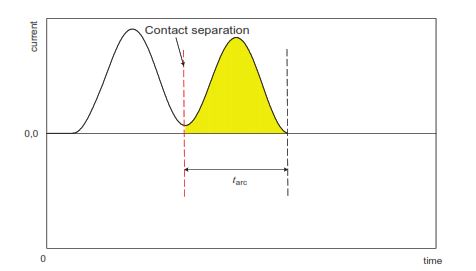
Figure 1: Example of a test for test duty 5
For test duties 6A and 6B, the test procedure shall include a prospective test current waveform where the r.m.s. value of the a.c. component of this current is 0,74 Iscg for test-duty 6 A and Iscg for test-duty 6B respectively and current peaks and relative minimums until the first current zero-crossing shall be recorded. The prospective test current waveform shall have three full cycles before the first current zero occurs in order to show two relative minimums without zero crossing (see Figure 2).
The contact separation shall occur not later than 2,6 cycles before the first current zero of the prospective current. This setting shall result in the required degree of asymmetry at contact separation and in an arcing time of at least 1,5 cycles.
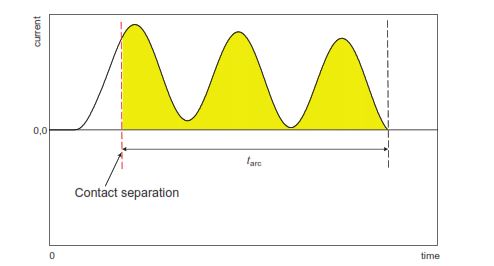
Figure 2: Example of test for test duties 6A and 6B
We can see Test duties to demonstrate the generator-source short-circuit making and breaking current capability for three-phase tests from IEC/IEEE 62271-37-013 in Table 1.
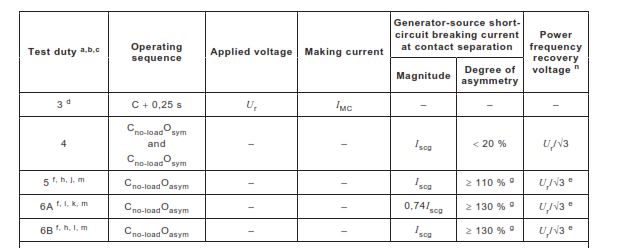
Table 1: IEC/IEEE 62271-37-013 table for test duties to demonstrate the generator-source short-circuit making and breaking current capability for three-phase tests
In this table:
Ur: rated voltage of the generator circuit-breaker.
I scg: r.m.s. value of the a.c. component of the rated generator-source short-circuit breaking current of the generator circuit breaker.
Test-duty 5 is mandatory for class G1 generator circuit breakers but not mandatory for class G2 generator circuit breakers as it is covered by test-duty 6B.
Test-duty 6A is mandatory only for class G1 generator circuit breakers.
Test-duty 6B is mandatory only for class G2 generator circuit breakers.
Also, we can see Test duties to demonstrate the generator-source short-circuit making and breaking current capability for single-phase tests from IEC/IEEE 62271-37-013 in Table 2:
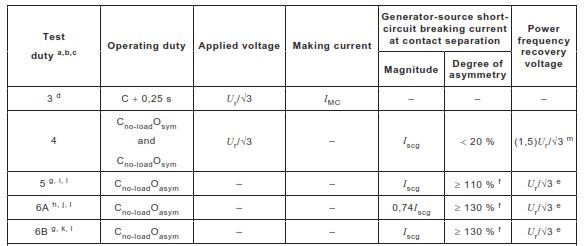
Table 2: IEC/IEEE 62271-37-013 table for test duties to demonstrate the generator-source short-circuit making and breaking current capability for single-phase tests
In this table :
Ur: rated voltage of the generator circuit breaker.
I scg: r.m.s. value of the a.c. component of the rated generator-source short-circuits current of the generator circuit-breaker.
Test-duty 5 is mandatory for class G1 generator circuit-breakers but not mandatory for class G2 generator circuit-breakers as it is covered by test-duty 6B.
Test-duty 6A is mandatory only for class G1 generator circuit breakers.
Test-duty 6B is mandatory only for class G2 generator circuit breakers.



